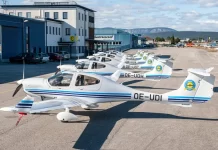In the heart of Africa, the aviation industry was soaring to new heights. July 2024 marked a milestone in the continent’s journey towards better connectivity, increased passenger traffic, and improved operational efficiency. The skies above Africa were buzzing with activity, as airlines expanded their routes, upgraded fleets, and responded to the ever-growing demand for both domestic and international travel.
One of the most remarkable achievements was the 7% increase in seat availability across Global Africa. In July 2023, there were 16 million seats available, but by July 2024, that number had climbed to 17 million. Intra-Africa routes, vital for connecting the continent’s diverse regions, also experienced a 3% rise in seat availability. New routes were opening up, and existing ones were being expanded, creating a web of connectivity that spanned the continent.
Airlines were not just adding seats; they were making better use of them. The Available Seat Kilometers (ASKs) for July 2024 exceeded those of July 2023 by an impressive 9%. The Revenue Passenger Kilometers (RPKs) also saw a modest but significant 1.3% year-over-year increase. This growth was more than just numbers—it was a testament to the increasing confidence of travelers and the operational prowess of African airlines.
The African Airlines Association (AFRAA) estimated that passenger traffic for African airlines would grow by 15% in 2024 compared to the previous year. This growth was not limited to local routes. African carriers were poised to hold 50.1% of the capacity on international routes, with the remaining 49.9% controlled by non-African carriers. However, on intercontinental routes, non-African carriers still dominated, holding 62.9% of the capacity compared to Africa’s 37.1%.
The growth in connectivity was evident in the bustling hubs of Addis Ababa, Johannesburg, Lusaka, and Lomé. These cities were becoming critical nodes in the continent’s expanding network, offering passengers more options and better connections than ever before. As a result, airlines reported improved passenger revenue. In May 2024 alone, revenue reached a staggering $1.66 billion, up 4% from $1.59 billion in April 2023.
Despite these successes, the industry faced challenges. The global price of Jet A1 fuel, a critical component of airline operations, fluctuated throughout the month. By the week ending July 26th, 2024, the average price had dipped slightly by 2.1% to $98.68 per barrel. These fluctuations underscored the volatility of the global fuel market, a factor that airlines constantly had to navigate.
In the corridors of power, leaders across Africa were taking bold steps to enhance economic integration and regulatory harmonization. On July 25, 2024, the COMESA-EAC-SADC Tripartite Free Trade Area (TFTA) Agreement came into effect. This historic agreement, representing 75% of the Tripartite’s GDP, aimed to streamline market access, reduce business costs through improved infrastructure, and foster industrial development. The TFTA was more than just a trade deal—it was a vision for a more connected and prosperous Africa.
In Nigeria, the government demonstrated its commitment to economic stability by suspending a proposed 800% increase in navigation charges by the Nigerian Airspace Management Agency (NAMA). This decision was a relief for airlines operating in Nigeria, ensuring that the sector remained affordable and operationally viable.
Meanwhile, in Uganda, a new collaboration with the UAE was set to transform the region’s connectivity. Plans were underway to develop a third international airport near Kidepo National Park. This strategic infrastructure enhancement was expected to boost connectivity and spur economic growth, not just in Uganda, but across the region.
In Ethiopia, the National Bank introduced the Foreign Exchange Directive No. FXD/01/2024. This directive marked a significant shift towards a market-based foreign exchange rate system, designed to increase financial predictability and operational flexibility for businesses. It was part of a broader initiative to liberalize Ethiopia’s economy, making it easier for businesses to access foreign currency and encouraging foreign investment.
While these developments painted a picture of progress, challenges remained. OPSGROUP, an industry group focused on aviation safety, convened a forum to address the alarming rise in GPS Spoofing incidents. The group noted that such incidents had spiked by 400% in the first quarter of 2024, prompting urgent discussions on flight safety, technical solutions, regulatory responses, and mitigation strategies.
Across the world, the aviation industry was grappling with evolving regulatory demands and environmental sustainability goals. The Lufthansa Group, in response to these challenges, announced an Environmental Cost Surcharge, set to take effect on January 1, 2025. This surcharge, ranging from 1 to 72 euros, was intended to offset costs associated with the statutory blending quota for Sustainable Aviation Fuel (SAF) and adjustments to the EU Emissions Trading System (EU ETS).
Security was also a top priority. The International Civil Aviation Organization (ICAO) issued the second edition of the Global Aviation Security Plan (GASeP). This updated plan emphasized enhancing security culture, technological innovation, and cooperation among aviation stakeholders to mitigate risks and improve oversight and quality assurance across global aviation operations.
As the sun set on July 2024, Africa’s aviation industry stood at the crossroads of growth and transformation. The continent was charting a course towards a brighter, more connected future, where the skies were not just a space for travel, but a symbol of Africa’s resilience, innovation, and boundless potential.













